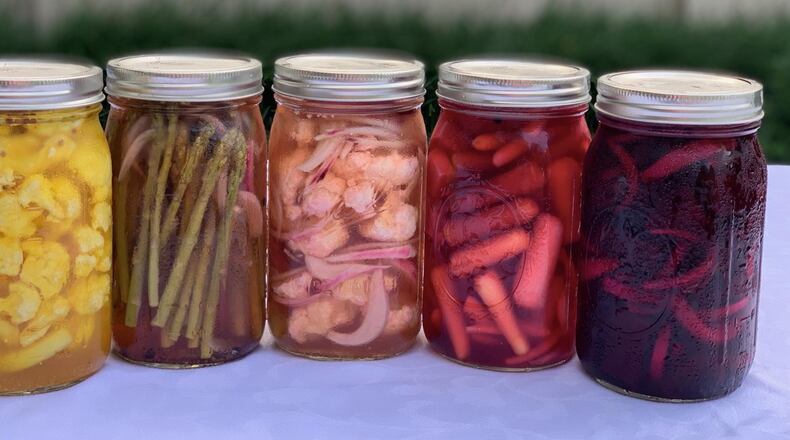You know what’s even better than pickled cucumbers? Pickled carrots! Pickled cauliflower! Pickled any fresh raw vegetable that’s in your crisper drawer!
Pickled veggies are crunchy, tangy and tart. You can enjoy them straight from the jar (my preferred method), or on top of sandwiches and pizzas. Add them to potato salad, egg salad or pasta sauce for new takes on old favorites. Serve them on the side of crudité and antipasto platters for bonus color and flavor. Or tie a pretty ribbon around a jar for a thoughtful, homemade hostess gift that solves the wine-or-candle dilemma. Best of all, pickled veggies are crazy-easy to make, so you can always have jars of them on hand.
Peel your vegetables if you would typically do so before eating (parsnips, I’m looking at you). Thick, dense veggies like beets and potatoes should be chopped into small, equal sizes. Long, slender veggies like green beans and asparagus are fine as is. There’s no need to cook your vegetables in advance; raw veggies retain some crunch, which is a relief to those of us in the anti-soggy-pickles club. However, if you feel an overwhelming need to heat up your kitchen, you can blanch your veggies before pickling so that their color remains vibrant.
Pack your veggies in a squeaky-clean canning jar, and throw in a clove of garlic and a handful of sliced onions. You can use either white or red onions. There will be no flavor difference between the two, although red onions will turn your white veggies a lovely shade of pink. Then add a cup of mild vinegar, like apple cider vinegar or rice wine vinegar. In a pinch, you can use red or white wine vinegar, but please avoid expensive balsamic and harsh plain white vinegar.
Drizzle 2 tablespoons of honey, maple syrup, or sugar into the jar. If you’re using a stronger vinegar, go ahead and add an extra spoonful of sweetness for balance. Season your vegetables with salt and pepper. Top with enough water that the vegetables are submerged, screw on the lid, shake well, and you’re all done. Place your pickles in the refrigerator and let the fermentation magic happen. Light veggies, like cauliflower florets, will be ready to enjoy the next day. Denser veggies will become crisp-tender after 3-5 days. Your pickles will keep in the refrigerator for up to 3 weeks, although mine have been known to disappear in a day.
Once you get the hang of pickling, experiment by adding different herbs and aromatics. Fresh dill is a no-brainer. Cloves add warm, spicy undertones, and work particularly well with pickled fennel or sweet potatoes. Ginger adds a kick to carrots and mushrooms. Turmeric and saffron give warm notes, and a golden hue, to cauliflower and summer squash. When it comes to refrigerator pickles, the only hard part is deciding what to pickle next.
Other recommended flavor combinations:
Asparagus + garlic + mustard seeds
Beets + basil + fresh ginger
Baby carrots + dill + coriander
Cauliflower + cumin + saffron
Green beans + red pepper + tarragon
RELATED:
Read more stories like this by liking Atlanta Restaurant Scene on Facebook, following @ATLDiningNews on Twitter and @ajcdining on Instagram.
About the Author
Keep Reading
The Latest
Featured




